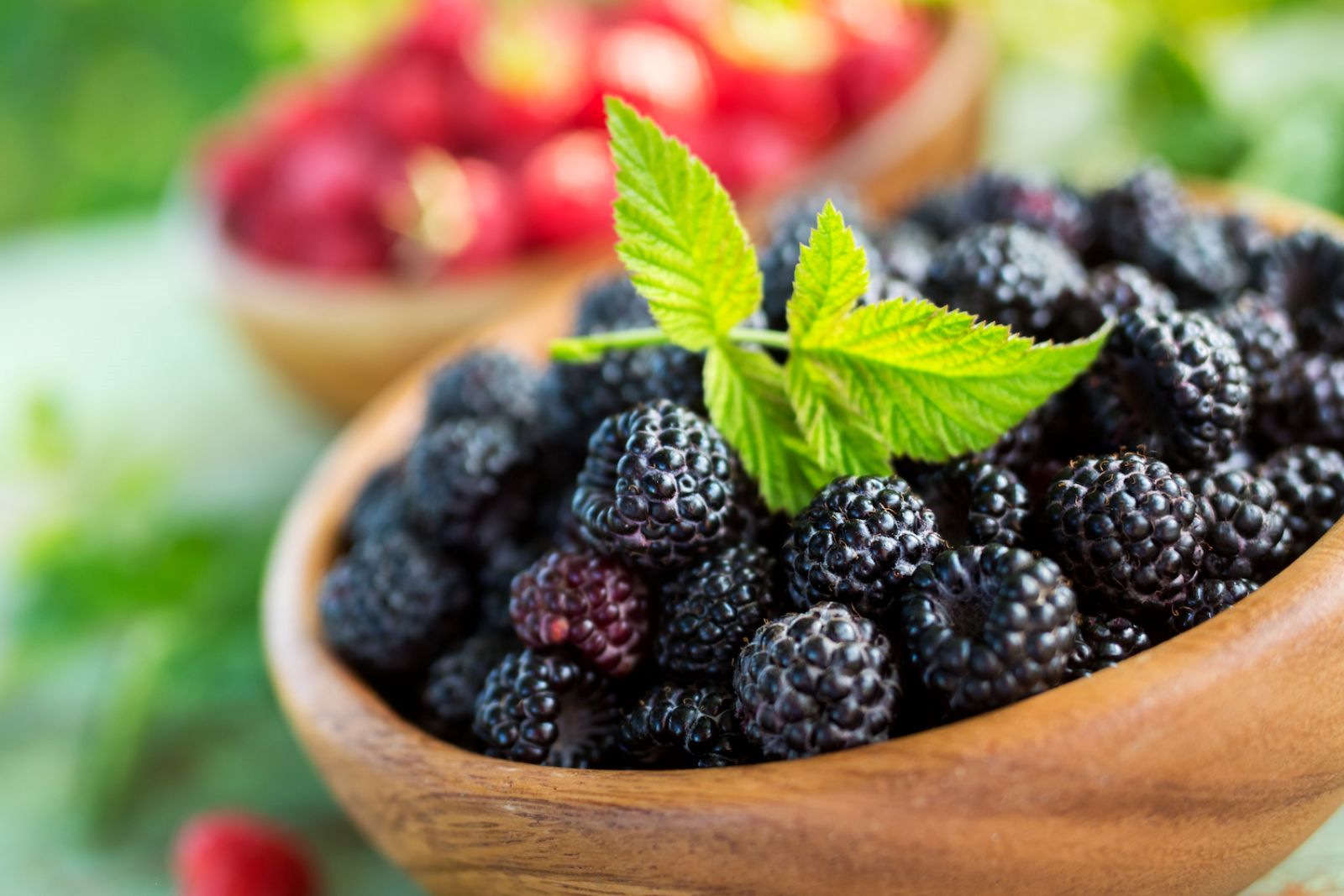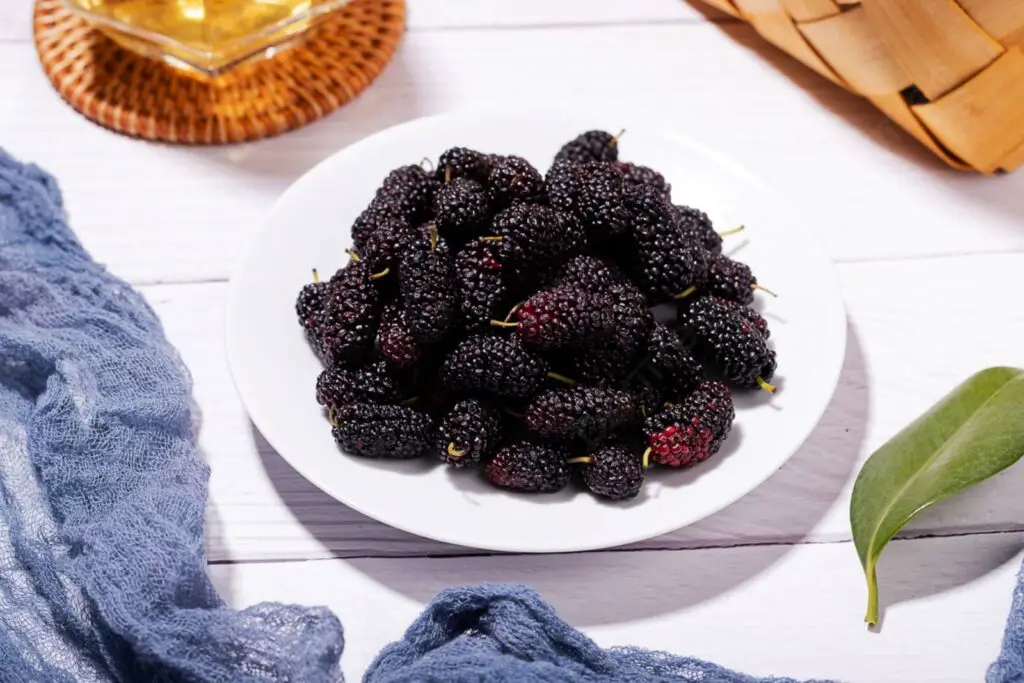
Black raspberries, with their rich color and delectable taste, are a delightful summer fruit that many enjoy. However, their season is fleeting. To savor their goodness throughout the year, freezing black raspberries is an excellent option. By following a few simple steps, you can preserve their freshness and enjoy the burst of flavor they bring to smoothies, baked goods, and a variety of culinary creations. Let’s explore the process of freezing black raspberries and unlock the key to enjoying their vibrant sweetness whenever you desire.
Here are the simple steps to freeze black raspberries:
Step 1: Prepare the Black Raspberries
To ensure the best results when freezing black raspberries, it is crucial, to begin with fresh and fully ripe berries. Here’s a detailed explanation of this important first step:
- Freshness is Key: When selecting black raspberries for freezing, prioritize those that are freshly picked. Look for berries that are firm, plump, and vibrant in color. Fresh berries have a higher water content, which contributes to better freezing results.
- Ripe and Sweet: Ensure that the black raspberries you choose are fully ripe. Ripe berries are sweeter and have a more intense flavor. They also have a softer texture, making them ideal for freezing. Ripe black raspberries are usually deep purple or black.
- Inspect for Damage or Mold: Thoroughly examine the berries before harvesting or purchasing them. Avoid berries with any signs of damage, such as bruising or crushing, as they may not freeze well. Also, discard any berries that show signs of mold or spoilage, as they can affect the quality of the other berries during freezing.
- Harvesting Time: For optimal results, it is recommended to harvest black raspberries early in the morning. During this time, the berries are typically cool and at their peak freshness. The cooler temperatures in the morning help preserve the flavor and texture of the berries, ensuring better results when they are frozen.
By starting with fresh, ripe black raspberries that are free from any damage or mold, you set the stage for successful freezing. This careful selection process ensures that the berries maintain their quality and taste throughout the freezing and thawing process, allowing you to enjoy their goodness even after they are out of season.
Step 2: Sort and Clean
After harvesting the black raspberries, the next step is to sort through them and clean them properly. Here’s a detailed explanation of this crucial step:
- Sorting for Quality: Take the harvested black raspberries and carefully sort through them. Look for any overripe or damaged berries, as well as any leaves or stems that may have been collected during the harvest. Removing these undesirable elements ensures that only high-quality berries are frozen.
- Gentle Rinse: Once the sorting is complete, it’s time to clean the berries. Fill a bowl or a colander with cold water. Gently place the black raspberries in the water and swish them around lightly. This will help remove any dirt, debris, or residual plant material that may be clinging to the berries.
- Avoid Crushing or Bruising: Black raspberries are delicate and can easily bruise or become crushed if handled roughly. To prevent this, be extremely gentle while rinsing the berries. Avoid using excessive force or stirring them vigorously in the water. Treat them with care to preserve their shape, texture, and overall quality.
- Drain and Dry: After rinsing, carefully lift the black raspberries out of the water and place them in a colander or on a clean kitchen towel. Allow the excess water to drain off naturally. You can gently shake the colander or lightly pat the berries with a paper towel to remove any remaining moisture.
By sorting through the harvested black raspberries and removing any overripe or damaged berries, you ensure that only the best ones are used for freezing. Cleaning the berries gently helps eliminate any dirt or debris, maintaining their overall cleanliness. It is crucial to handle the berries with care during this process to avoid crushing or bruising them. Following these steps ensures that the black raspberries are in optimal condition before moving on to the next stages of freezing, resulting in the best quality berries for later use.
Can I freeze black raspberries without removing the stems?
It is generally recommended to remove the stems from black raspberries before freezing them. While it is possible to freeze black raspberries with the stems intact, it may lead to a less desirable texture and taste. The stems can become tough and fibrous when frozen, affecting the overall quality of the berries. Removing the stems before freezing ensures a better culinary experience when using the black raspberries later on.
Step 3: Dry the Black Raspberries
After the black raspberries have been cleaned, it is important to dry them properly before proceeding with the freezing process. Here’s a detailed explanation of this step:
- Air Drying: Place the cleaned black raspberries on a clean kitchen towel or a layer of paper towels. Ensure that the surface is clean and free from any contaminants. Arrange the berries in a single layer, allowing some space between them. This will facilitate proper air circulation and drying.
- Avoid Cloth Towels: It is recommended to avoid using cloth towels for drying the berries, as they may leave behind lint or fibers that can cling to the delicate fruit. Opt for paper towels or a clean, lint-free kitchen towel to prevent any unwanted residue on the berries.
- Gently Patting: To remove any excess moisture from the black raspberries, gently pat them with a paper towel. Lightly press the towel against the berries without applying too much pressure. This will absorb any remaining moisture on the surface of the berries, allowing them to dry more effectively.
- Be Gentle: During the drying process, handle the black raspberries with care to avoid crushing or damaging them. Their delicate texture can easily be compromised if mishandled. Take your time and exercise caution to preserve the shape and integrity of the berries.
By allowing the black raspberries to air dry on a clean kitchen towel or paper towel, you allow them to shed any residual moisture. Avoiding cloth towels helps prevent lint or fibers from adhering to the berries. Gently patting the berries with a paper towel removes excess moisture, preparing them for the next step of flash-freezing. With proper drying, the black raspberries will freeze more effectively, maintaining their quality and texture throughout their time in the freezer.
Step 4: Flash-Freeze
Flash-freezing is a crucial step in the process of freezing black raspberries to ensure that they maintain their integrity and prevent them from clumping together. Here’s an explanation of this important step:
- Spreading the Berries: Take the dried black raspberries and spread them out in a single layer on a baking sheet lined with parchment paper. It is important to ensure that the berries are not touching or overlapping each other. This spacing allows for efficient freezing and prevents the berries from sticking together.
- Parchment Paper: Using parchment paper on the baking sheet helps prevent the black raspberries from sticking to the surface and makes it easier to remove them once frozen. The non-stick nature of parchment paper ensures that the berries retain their shape and do not become damaged during freezing.
- Individual Integrity: By arranging the black raspberries in a single layer without any contact, the flash-freezing process helps maintain the individual integrity of each berry. This means that once frozen, they will retain their distinct shape and texture, allowing for easier handling and portioning when needed later on.
- Freezing Time: Place the baking sheet with the spread-out black raspberries in the freezer and allow them to freeze for about 1 to 2 hours. The exact freezing time may vary depending on the temperature of your freezer and the quantity of berries being frozen. It is essential to ensure the berries are completely frozen before moving on to the next step.
Flash-freezing the black raspberries quickly freezes them individually, preserving their structure and preventing clumping. This step is crucial for maintaining the quality of the berries and allows for easier portioning and usage later on. By following this process, you’ll have well-frozen black raspberries ready for long-term storage and future culinary adventures.
Step 5: Pack to Freeze
After flash-freezing the black raspberries, it is essential to package them properly to maintain their quality and prevent freezer burn. Here’s an explanation of this crucial step:
- Airtight Containers or Freezer Bags: Transfer the flash-frozen black raspberries into airtight containers or resealable freezer bags. These containers or bags should be specifically designed for freezer use to ensure the best preservation of the berries. Airtight packaging helps to prevent air exposure, which can cause freezer burn and deteriorate the quality of the berries over time.
- Minimizing Air Exposure: When placing the black raspberries into the containers or bags, ensure that you remove as much air as possible. Excess air can promote freezer burn and lead to loss of flavor and texture. Press the containers or bags gently to remove any trapped air before sealing them tightly.
- Labeling and Dating: To keep track of the freezing date and ensure proper rotation, label the containers or bags with the freezing date. This labeling practice allows you to identify the oldest batches of black raspberries in your freezer and use them first, ensuring freshness and optimal taste.
Proper packaging is crucial in preserving the quality of the black raspberries during storage. Airtight containers or bags, along with the removal of excess air, create a protective barrier against freezer burn and maintain the flavor, texture, and overall quality of the berries. Labeling the containers or bags with the freezing date helps you keep track of their freshness and allows for better organization in your freezer.
Step 6: Store in the Freezer
After packaging the black raspberries for freezing, proper storage is essential to maintain their quality and extend their shelf life. Here’s an explanation of this crucial step:
- Coldest Part of the Freezer: Place the containers or bags of frozen black raspberries in the coldest part of your freezer. This area is usually at the back or bottom of the freezer, where the temperature remains consistently low. Storing the berries in the coldest part of the freezer helps ensure that they remain frozen solid and minimizes the risk of thawing or freezer burn.
- Recommended Freezer Temperature: Set your freezer temperature to at or below 0°F (-18°C) to maintain the optimal storage conditions for the black raspberries. This low temperature prevents the berries from thawing and preserves their quality for a longer duration. It is important to check and monitor the freezer temperature regularly to ensure it remains within the recommended range.
- Extended Shelf Life: When properly stored, black raspberries can last up to 12 months in the freezer. However, for the best quality and flavor, it is recommended to use them within the first 8 to 10 months. Proper packaging and storage conditions, along with the recommended freezer temperature, contribute to the berries’ extended shelf life.
By storing the frozen black raspberries in the coldest part of your freezer and maintaining the recommended temperature, you ensure that they stay frozen solid and retain their quality for an extended period. Following these storage guidelines allows you to enjoy the flavorful goodness of black raspberries throughout the year, even when they are out of season.
Step 7: Thaw the Frozen Black Raspberries
After properly freezing the black raspberries, the time comes to thaw them before using them in your favorite recipes. Here’s an explanation of this final step:
- Refrigerator Thawing: When you’re ready to use the frozen black raspberries, remove the desired amount from the freezer. Place them in a bowl or container and transfer them to the refrigerator. Thawing the berries slowly in the refrigerator overnight is the recommended method. This gradual thawing process helps retain the berries’ texture and flavor while minimizing any potential loss of juice.
- Retaining Texture and Flavor: Thawing the black raspberries slowly in the refrigerator allows them to thaw evenly and gently. This helps to maintain their texture and preserve their delicate flavor. Avoid using quick thawing methods such as running water or microwaving, as they can result in a loss of texture and flavor.
- Utilizing Thawed Black Raspberries: Once the black raspberries are fully thawed, they are ready to be used in a variety of recipes. Add them to smoothies for a burst of fruity goodness, use them to make jams or preserves, incorporate them into pies, or use them as a flavorful topping for desserts such as ice cream or yogurt. The thawed black raspberries are versatile and can enhance a wide range of culinary creations.
By thawing the frozen black raspberries slowly in the refrigerator, you ensure that their texture and flavor remain intact. The gentle thawing process preserves the delicate structure of the berries, making them suitable for various recipes. Whether you prefer them in sweet treats or as a nutritious addition to your meals, thawed black raspberries bring a burst of vibrant flavor and versatility to your culinary endeavors.
Other related questions
Can you refreeze black raspberries?
Refreezing black raspberries is possible, but it is generally not recommended due to potential texture and quality issues. When black raspberries undergo multiple freeze-thaw cycles, they can become mushy, lose flavor, and experience degradation. It is best to consume black raspberries after the initial thawing to maintain their optimal taste and texture.
How do I know if the black raspberries have gone bad after being frozen?
After black raspberries have been frozen, there are several signs to look for to determine if they have gone bad. Check for any mold growth, unusual discoloration, or a strong off-putting odor, as these are indicators of spoilage. Additionally, if the black raspberries appear excessively soft, and mushy, or have a significantly altered texture, it is likely that they have deteriorated and should not be consumed.
Are there any special considerations when freezing black raspberries?
When freezing black raspberries, there are a few special considerations to keep in mind. Firstly, it is important to handle delicate berries gently to avoid crushing or damaging them. Secondly, it is recommended to remove any stems or debris before freezing to ensure optimal texture and taste. Lastly, proper packaging in airtight containers or bags, along with labeling and storing in the coldest part of the freezer, helps maintain the quality of frozen black raspberries for an extended period.
What are other methods for freezing black raspberries?
In addition to the conventional method of flash-freezing black raspberries on a baking sheet, there are alternative methods for freezing them. One option is to freeze black raspberries in a single layer on a tray or plate before transferring them to containers or bags for long-term storage. Another method involves making black raspberry purée or sauce and freezing it in ice cube trays for convenient portioning. These alternative methods offer flexibility in how you freeze and use black raspberries based on your preferences and intended culinary applications.
Should I freeze black raspberries individually or in clumps?
It is generally recommended to freeze black raspberries individually rather than in clumps. Freezing them individually allows for easier portioning and flexibility when using them in various recipes. It also helps prevent the berries from sticking together, enabling you to easily remove the desired amount without thawing the entire clump. Individual freezing ensures convenience and preserves the quality of the black raspberries for future use.
Can I freeze black raspberries with sugar or syrup?
Yes, you can freeze black raspberries with sugar or syrup to enhance their flavor and preserve their texture. The sugar or syrup acts as a sweetener and helps retain moisture in the berries during freezing. To do this, gently toss the black raspberries with the desired amount of sugar or syrup before packaging them for freezing. However, it’s important to note that the addition of sugar or syrup may slightly alter the texture and taste of the berries.
Can I freeze black raspberries for use in baking?
Absolutely! Freezing black raspberries is a great way to preserve them for future use in baking. The frozen berries can be used directly in various baked goods like pies, tarts, muffins, and cakes without the need for thawing. Simply incorporate the frozen black raspberries into the batter or filling as directed in the recipe, and adjust the baking time accordingly. The frozen berries will release their juices and add a burst of flavor to your baked treats.
Can I use frozen black raspberries in smoothies?
Yes, frozen black raspberries are a fantastic addition to smoothies. Their vibrant color and sweet-tart flavor add a refreshing and nutritious element to the blend. Simply toss the frozen black raspberries into the blender along with your choice of other fruits, liquids, and any desired additions such as yogurt or sweeteners, then blend until smooth. The frozen berries contribute a thick and icy texture, making the smoothie more enjoyable and satisfying.
Do frozen black raspberries retain their nutritional value?
Frozen black raspberries retain a significant portion of their nutritional value. Freezing helps to preserve the vitamins, minerals, and antioxidants present in the berries. While some minor nutrient loss may occur during the freezing process, the overall nutritional content remains relatively intact. Including frozen black raspberries in your diet can still provide you with beneficial nutrients and contribute to a healthy lifestyle.








